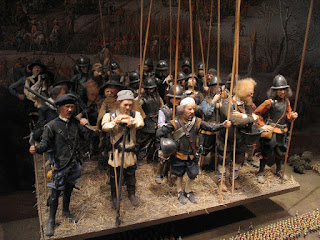For the majority of the history of warfare, the shield has featured prominently. It was mostly used by infantry and then by archers and cavalry. It had great utility in deflecting blows and protecting the user from missiles.
With such great utility, how did it decline in usage?
Some might say that gunpowder small arms had something to do with it. The fact is that shields were increasingly discarded by close combat troops prior to the widespread adoption of firearms.
A shield was typically made from wooden slats (or wicker in some Middle Eastern constructions) and covered with rawhide for extra reinforcement and protection.
Some early depictions of the shield in massed combat were Assyrian reliefs showing spearmen with large tower shields protecting archers and slingers.
 |
| Assyrian soldiers |
The Persian Sparabara functioned in the same way. The use of the shield was never more vital than in Phalanx or shield wall formations where the shield would protect not just the carrier but the soldier next to him.
 |
| Greek Phalanx formation |
 |
| Sassanid Cataphract |
Ancient soldiers almost invariably did not have all encompassing body armour. The exceptions to this rule were the cataphracts who armoured themselves from head to toe (along with their horses) with scale and mail armour. They did not have shields.
The large shields typically served to protect the body in close combat (and in some contexts to serve as an offensive weapon). By raising the shield, missiles were deflected or stopped. As the medieval era progressed, more men-at-arms would wear mail hauberks and gambesons together. This was slowly supplemented by plate armour at the limbs. Later, steel breastplates and coats of plates were used. The richer knights could afford to armour themselves in such a comprehensive way which left few parts of the body vulnerable to missiles (at a distance) and slashing blows in close combat.
 |
| The Gambeson consisted of linen layers |
Mail armour can still be pierced at close range by arrows, along with hard thrusts using spears and swords. A soldier could still be damaged by blunt force trauma even if the armour was not pierced. This gave rise to the use of hardened plate armour by the 1400s, which was almost invulnerable to direct piercing strikes by both arrows and piercing weapons.
 |
| Late medieval full plate |
This saw the decline in the use of shields for elite fighting men for the same reason that they were discarded by the ancient cataphracts.
But why was it discarded by the regular infantry? It was not until later in the mid-15th century that cheap, munitions grade plate armour became cheap and available for the common soldier.
 |
| The blast furnace enabled mass production of plate armour |
As the medieval era progressed, the knightly charge became increasingly devastating, prompting enemy infantry to develop effective counters.
The main method was to use a pike (or long spear) around 6 meters in length to deter cavalry from charging infantry formations.
 |
| Swiss pike and shot formation |
Because the pike was a two-handed weapon, the soldiers could not use a shield at the same time. Alexander the Great’s pike armed infantry abandoned shields for the same reason.
The halberd became widely used as an effective weapon against both infantry and cavalry. This, along with other polearms required the use of two hands.
 |
| Pole weapons - Fouchard and partisan |
However, shields were not eliminated entirely from this era. Crossbowmen, who were typically less well armoured, would use a shield called a pavise, which deflected missiles and protected the soldier while he reloaded.
 |
| Large Pavise for crossbowmen |
All of this does not completely answer the question of why shields were abandoned. Shields were cheap and large shields could protect the body against a wide range of attacks, so why would elite, sword armed infantry abandon its use in favour of heavy armour?
There are a few answers to this question, but the most obvious answer is ergonomics. It is easier to carry something on your body rather than holding it away from your body, as one does with a shield. It could tire infantry over the course of a battle and in marching, particularly if they are poorer quality levies instead of professional soldiers.
The Roman legions used a large shield, but they did not generally march with it in the same way that they carried it in battle. They slung it over their shoulders. It should also be noted that Roman armour evolved by getting rid of encompassing body armour, starting with discarding greaves and the Phalanx era Corinthian helmet in favour of a more open design which facilitated better hearing and peripheral vision. They had the technology to make limb armour, such as the manica, but generally they did not use it. The large shield functioned for this purpose.
Another answer might lie in the sole use of shields today. The riot police have body armour and better modern helmets, but they still use large riot shields for a shield wall and testudo formation. They do this because it is better to take large stones on the shield than on the helmeted head, which could kill the wearer despite not being pierced by the missiles.
 |
| Riot police with shields |
Slingers were common in antiquity and would have thrown such missiles, but they declined in number for reasons explained on another blog.
Ultimately, the widespread use of firearms caused the decline in both armour and shields in Europe until the modern era.

Comments
Post a Comment